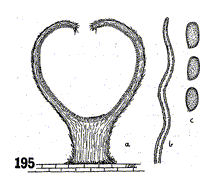|
 Lachnella coprosmae Lachnella coprosmae
BiostatusPresent in region - Indigenous. Endemic
Images (click to enlarge)
Caption: FIG. 195. Lachnella coprosmae. Section through the pileus (a), encrusted tortuous
hair from the pileus surface (b), and pip-shaped spores (c). |
Article: Cunningham, G.H. (1963). The Thelephoraceae of Australia and New Zealand. New Zealand Department of Scientific and Industrial Research, Bulletin 145: 359 p. Wellington:.
Description: Pilei annual, scattered, rarely crowded, membranous, fragile, clavate becoming urniform,
0.25-0.75 mm diameter, 0.5-1.25 mm long, attached by narrow bases; exterior bay or tan,
densely tomentose, abhymenial hairs tortuous, tapering to long-acuminate apices, to 3-5 µ
diameter, aseptate, unbranched, walls hyaline, 0.5 µ thick, staining, some encrusted with
deciduous crystals; margin inturned, fibrillose, lacerate; hymenia surface even, concave,
tan. Context pallid tan, to 80 µ thick, of closely compacted radiately arranged parallel
hyphae; generative hyphae to 4 µ diameter, walls 0.2 µ thick, tinted yellow, without clamp
connections. Hymenial layer to 45 µ deep, a close palisade of basidia and paraphyses.
Basidia clavate, 22-28 x 7-9 µ, bearing 2-4 spores; sterigmata erect, slender, to 5 µ long.
Paraphyses subclavate, 16-24 x 6-7 µ. Spores pip-shaped, obliquely apiculate, 7-8 x 3.5-4
µ, walls smooth, hyaline, 0.1 µ thick, often adhering in fours.
Habitat: HABITAT: Scattered on bark of dead twigs.
Distribution: TYPE LOCALITY: Pukekura; Westland, New Zealand.
DISTRIBUTION: New Zealand.
Notes: Characterised by the tortuous abhymenial hairs of the pileus surface, narrow pip-shaped spores,
tan colour of the fragile, irregularly shaped pilei, pallid yellow walls
of context hyphae, and absence of clamp connections. Abhymenial hairs are densely
crowded and stain deeply with aniline blue; at first they are encrusted with fine
crystals, which gradually disappear so that in mature plants most hairs are naked.
|